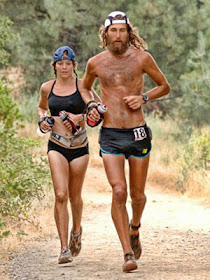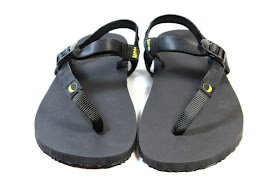Well, 2012 is coming to a close, and since we've survived the Mayan apocalypse it looks like I should start preparing for another year after all. Running-wise, the year has had its ups and downs but overall it’s been a remarkably productive time full of adventures for me. I know you’re dying to hear the details, so here is my 2012 in review.
I ran my first marathon (the Holualoa Tucson
Marathon). This was a huge jump in distance for me since I had finished my
first half marathon only six months earlier. It was also the first race I ran
in huaraches (my homemade original Lunas).
Emily and I went on a cruise to Hawaii (basically
an extremely belated honeymoon). Oddly enough, it ended up being our first
vacation to feature running as one of our main activities. We ran virtually
every day, including the seven days at sea, and when we were on the islands we
ran when we would have otherwise walked. What we found was that our runs were
some of our favorite moments of the trip and that running is an extremely
pleasant and efficient way to visit a place. Our next vacation is going to be
entirely on foot, and we can’t wait.
March
We ran our first trail race, the Mesquite Canyon
half marathon. After this race, all interest I ever had in running road races vanished. Honestly, I’m not sure how I ever put up with them—the hotel
cost, the hassle of parking, the crowds, the monotonous urban scenery, waiting
in line for 45 minutes for a porta potty, the people who think it’s okay to cut
in line for the porta potty even though everyone else has been waiting in line
for 45 minutes (Garrrghh!!!), and on and on.
June
June
Emily ran her first marathon (Rock n Roll San
Diego), paced by her loving husband/pacer/Sherpa (I brought a lot of snacks).
This was my second marathon and only the second time I had run farther than 22 miles. The experience was a mostly
positive one, though it highlighted for me how much I preferred trail races (I had
to consciously resist punching people in the porta potty line). On the plus
side, I ran part of the race barefoot, which was another first for me.
It was also in June that I started this blog,
which I’m sure was a significant event in the lives of many of you. It
certainly didn't seem very significant to me at the time since I assumed that
no one would ever read it.
In July I ran the Grand Canyon rim-to-rim. Now, this was
an adventure. In fact, it's still my favorite running adventure I've had to date.
Emily and I ran our first race on the Hopi reservation, a 10k in the ancient village of Oraibi. The experience made such an impact on me that I ended up writing a whole series of posts on Hopi races and running tradition.
We returned to Hopi land for Paatuwaqatsi 50k, an absolutely unique race and my first ultra.
September also marked the milestone of receiving my first pair of free shoes to review, which was pretty exciting for a shoe nerd with a limited budget. The unanticipated downside of my dawn of swag has been that ever since then I've had a backlog of gear that I haven't gotten around to reviewing yet. (Sorry guys; I'm working on it).
October
I ran my second 50k, Cave Creek Thriller.
I also had my first experience pacing and volunteering at Javelina Jundred, which inspired me to write this post on the Christ-like service common at ultras.
November
My attempt to run my first three ultras in three consecutive months resulted (predictably) in my first DNF at Pass Mountain 50k after I tweaked my Achilles tendon by adding speedwork on top of peak mileage. Not my brightest moment.
November wasn't all bad news though, since it saw the publication of my first book, a children's book about barefoot running that (in my biased but correct opinion) is the most adorable thing in the history of ever (though I should mention before the gods smite me for my hubris that the adorableness is mostly due to the fantastic illustrations which, unfortunately, were not done by me).
If that weren't enough, Emily and I also got the nutty idea of trying a fruitarian diet for a week, which (now a month later) has mushroomed into what is increasingly looking like a permanent lifestyle change. (Okay, I just realized I used not one but two food metaphors in that sentence and neither of them involved fruit. How's this: "We thought we'd be going bananas, but so far everything's been peachy"? Better?). I'm currently working on that post, and the results are surprising. Stay tuned.
December
My attempt to run my first three ultras in three consecutive months resulted (predictably) in my first DNF at Pass Mountain 50k after I tweaked my Achilles tendon by adding speedwork on top of peak mileage. Not my brightest moment.
November wasn't all bad news though, since it saw the publication of my first book, a children's book about barefoot running that (in my biased but correct opinion) is the most adorable thing in the history of ever (though I should mention before the gods smite me for my hubris that the adorableness is mostly due to the fantastic illustrations which, unfortunately, were not done by me).
If that weren't enough, Emily and I also got the nutty idea of trying a fruitarian diet for a week, which (now a month later) has mushroomed into what is increasingly looking like a permanent lifestyle change. (Okay, I just realized I used not one but two food metaphors in that sentence and neither of them involved fruit. How's this: "We thought we'd be going bananas, but so far everything's been peachy"? Better?). I'm currently working on that post, and the results are surprising. Stay tuned.
December has been a good month so far. I bounced back from my injury and ran a PR at McDowell Mountain Frenzy (report for that is coming as well). It was my first 50k where I genuinely felt good at the end, instead of wishing for death to take me like I usually do.
Last but not least, Emily is finally making the switch to huaraches. She bought herself a pair of Luna Leadville ATS's for Christmas and had a blast breaking them in during our Christmas morning 10 miler in the desert. Hopefully soon I won't be the only nut running around in sandals at our races.
Last but not least, Emily is finally making the switch to huaraches. She bought herself a pair of Luna Leadville ATS's for Christmas and had a blast breaking them in during our Christmas morning 10 miler in the desert. Hopefully soon I won't be the only nut running around in sandals at our races.
Next Year
So that's 2012. What does 2013 hold for me? Based on how surprising this year has been, I have no idea, but here is what I'm planning/hoping for:
- I will be attempting my first 50 miler at Coldwater Rumble on January 19. I'm a bit freaked out by the distance, but given how well my last 50k went I'm going to just close my eyes and jump. We'll see what happens.
- Once I have a 50 miler under my belt, I want to attempt a Grand Canyon double crossing (rim-to-rim-to-rim), preferably in the spring. Ever since my single crossing I've been itching to try it. Hopefully this will be the year.
- If everything goes well, I'd like to take a crack at Javelina Jundred next October. This is still a bit of a pipe dream at this point, and I'm certainly not signing up just yet, but a 100 miler is something I want to work toward in the coming year.
- I also want to make the year as injury-free as possible. To that end, my two resolutions are to:
(1) Accept that high-intensity speedwork just gets me injured and focus on mileage and gradually increasing my easy run pace.
(2) Cross-train more. I've increased the amount I do a lot this year and it has really helped my running, especially strength training on my legs (air squats, etc.).
-----------------------------------------------------------------------------------------------------

Order my children's book about barefoot running: What Should I Put on My Feet to Go Run?
So that's 2012. What does 2013 hold for me? Based on how surprising this year has been, I have no idea, but here is what I'm planning/hoping for:
- I will be attempting my first 50 miler at Coldwater Rumble on January 19. I'm a bit freaked out by the distance, but given how well my last 50k went I'm going to just close my eyes and jump. We'll see what happens.
- Once I have a 50 miler under my belt, I want to attempt a Grand Canyon double crossing (rim-to-rim-to-rim), preferably in the spring. Ever since my single crossing I've been itching to try it. Hopefully this will be the year.
- If everything goes well, I'd like to take a crack at Javelina Jundred next October. This is still a bit of a pipe dream at this point, and I'm certainly not signing up just yet, but a 100 miler is something I want to work toward in the coming year.
- I also want to make the year as injury-free as possible. To that end, my two resolutions are to:
(1) Accept that high-intensity speedwork just gets me injured and focus on mileage and gradually increasing my easy run pace.
(2) Cross-train more. I've increased the amount I do a lot this year and it has really helped my running, especially strength training on my legs (air squats, etc.).
-----------------------------------------------------------------------------------------------------

Order my children's book about barefoot running: What Should I Put on My Feet to Go Run?












































